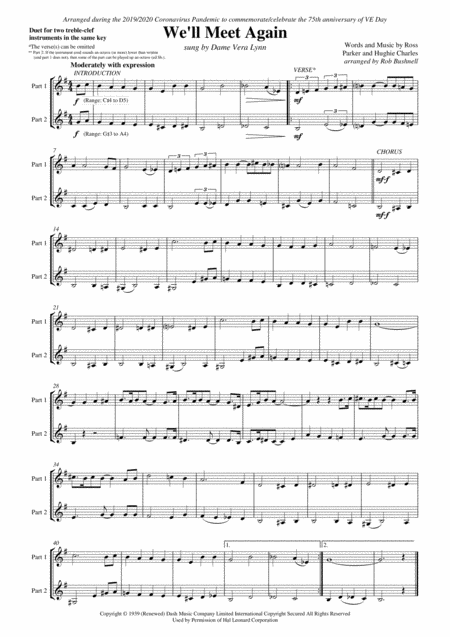B-Flat Trumpet,B-Flat trombone,Instrumental Duet - Level 3 - Digital Download SKU: A0.752396 Composed by Hughie Charles and Ross Parker. Arranged by Rob Bushnell. Film/TV,Opera,Patriotic,Traditional. 1 pages. RBMusic #5740059. Published by RBMusic (A0.752396). We'll Meet Again was written in 1939 by Ross Parker and Hughie Charles, and made famous by singer Dame Vera Lynn. The song is one of the most famous of the Second World War era. It later gave its name to the 1943 musical film We'll Meet Again, where Vera Lynn played the lead role. During the Cold War, Lynn's recording of the song was included in the package of music and programmes held in 20 underground radio stations of the BBC's Wartime Broadcasting Service (WTBS), designed to provide public information and morale-boosting broadcasts for 100 days after a nuclear attack. In 2005, Vera Lynn sang the song in London on the 60th Anniversary of VE Day in 2005, and, in 2020, a duet with Katherine Jenkins reached number 72 on the UK Singles Chart. Arranged during the 2019/2020 Coronavirus Pandemic to commemorate/celebrate the 75th anniversary of VE Day, it is designed for two treble-clef instruments in the same key. This version is in G major (written pitch) – part 1 has a written range from C#4 to D5 and part 2 has a written range from G#3 to A4. (For other parts/versions, see my other We’ll Meet Again titles.) A recording of the original song can be found here on YouTube: https://www.youtube.com/watch?v=HsM_VmN6ytk. Other searchable terms: Stanley Kubrick, Dr. Strangelove, Liberation Day Concert, Amsterdam, World War II, Benny Goodman, Peggy Lee, Mr. Tambourine Man, Rod Stewart, Perry Como, Barry Manilow, Johnny Cash, The Muppets Go to the Movies, The Muppets, Dudley Moore, Lily Tomlin, The Simpsons, Alfie Boe, VE Day 70, A Party to Remember, ABBA, Pink Floyd, Queen Elizabeth II, United Kingdom of Great Britain and Northern Ireland, COVID-19 pandemic virus, NHS Charities Together
